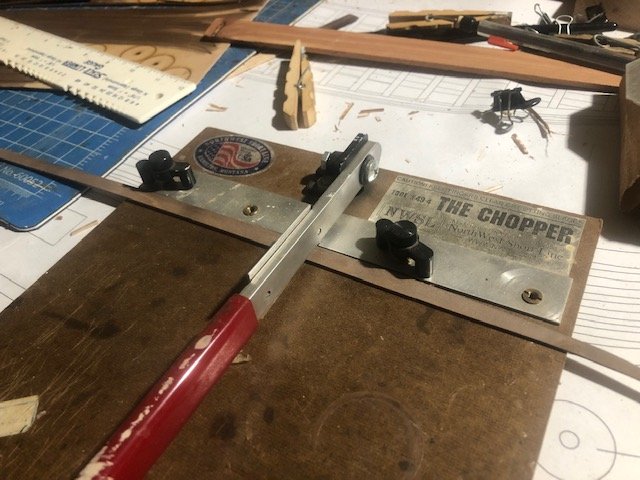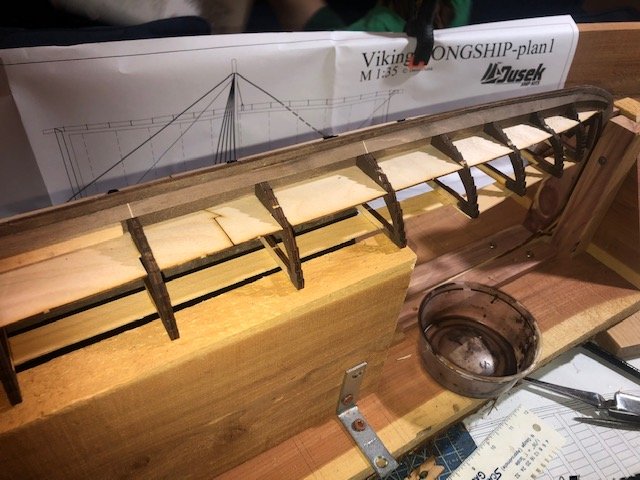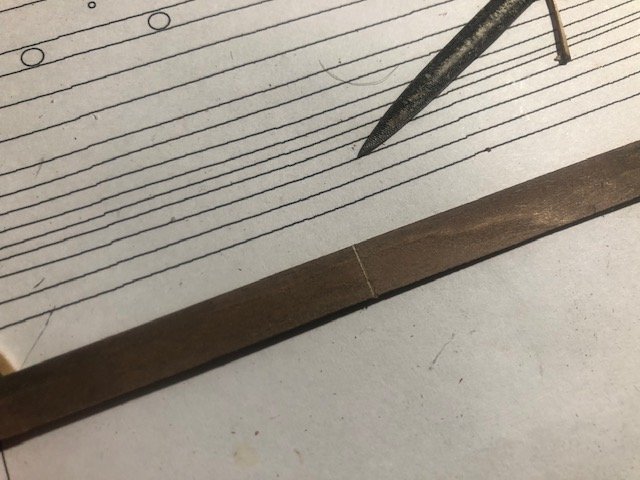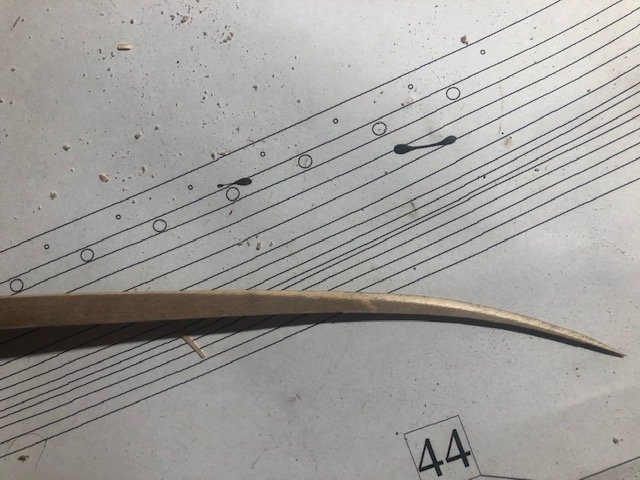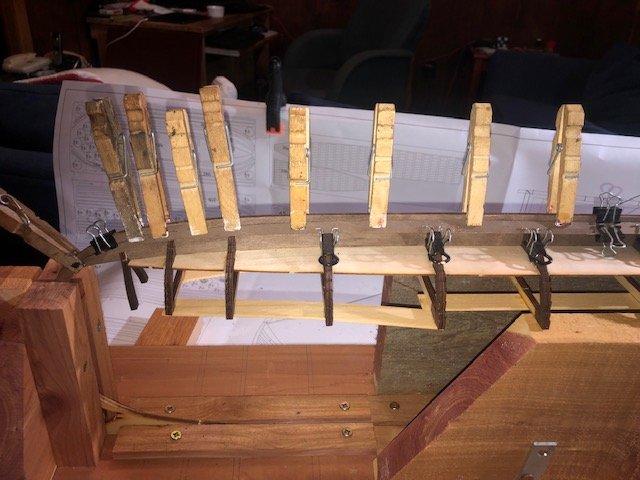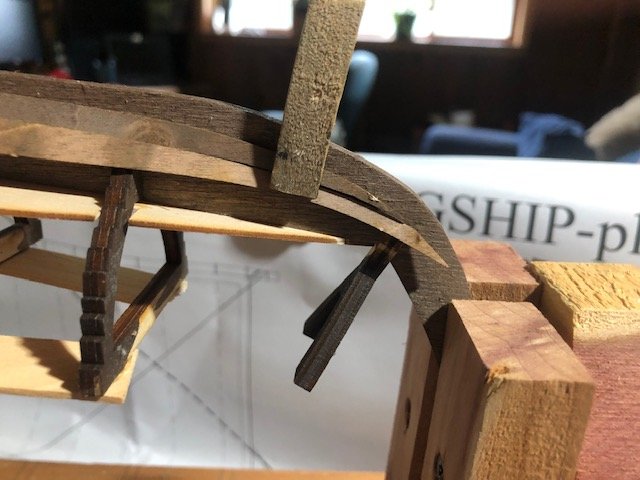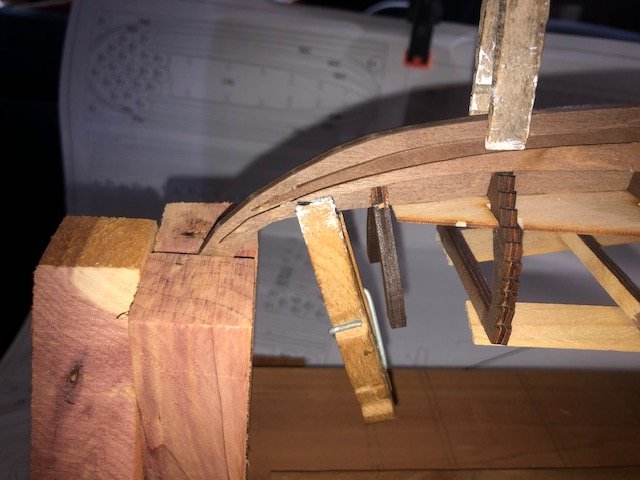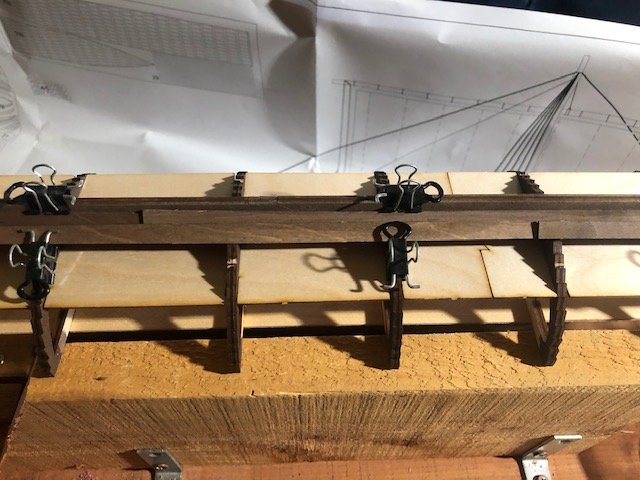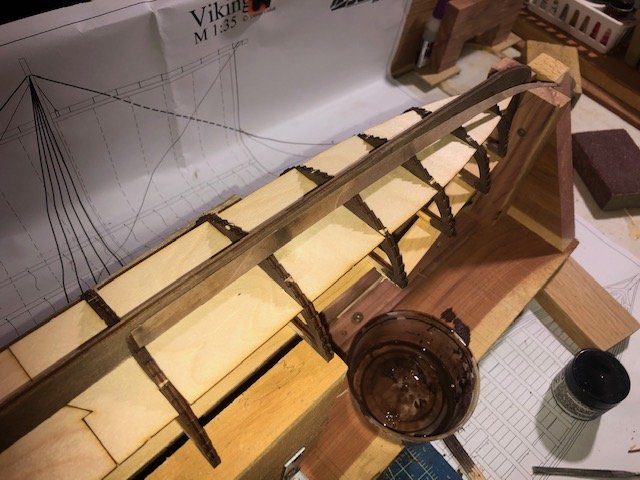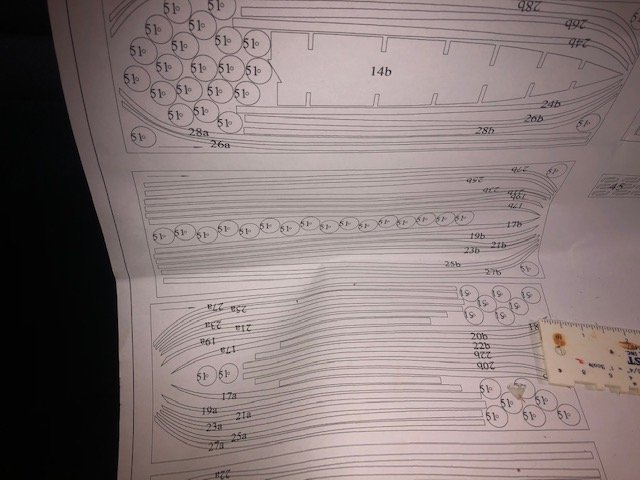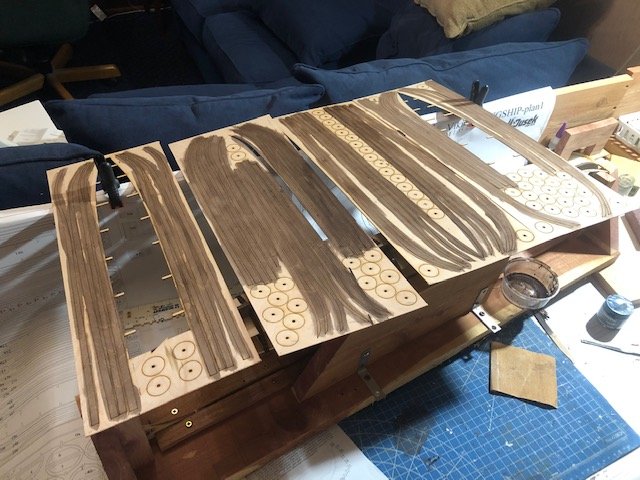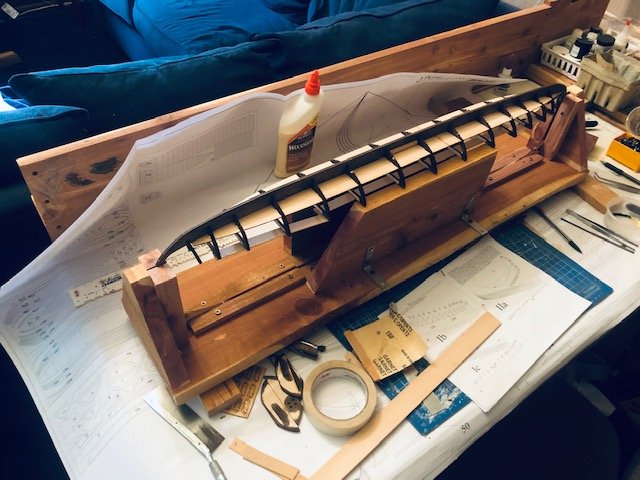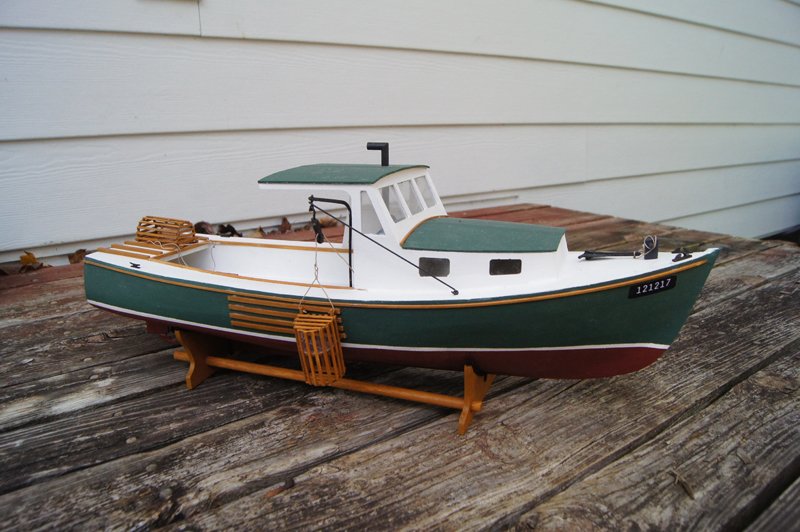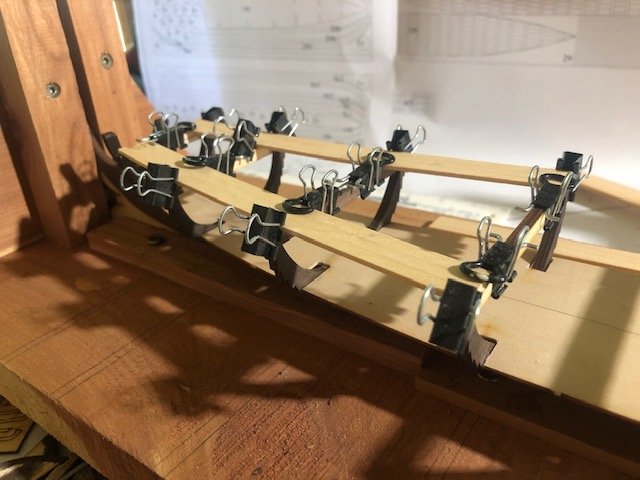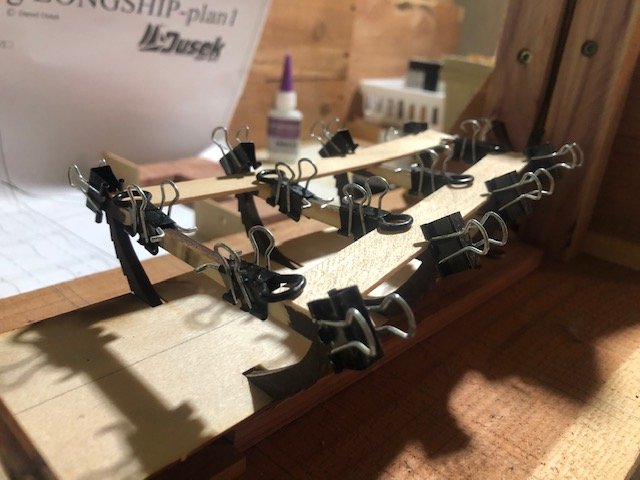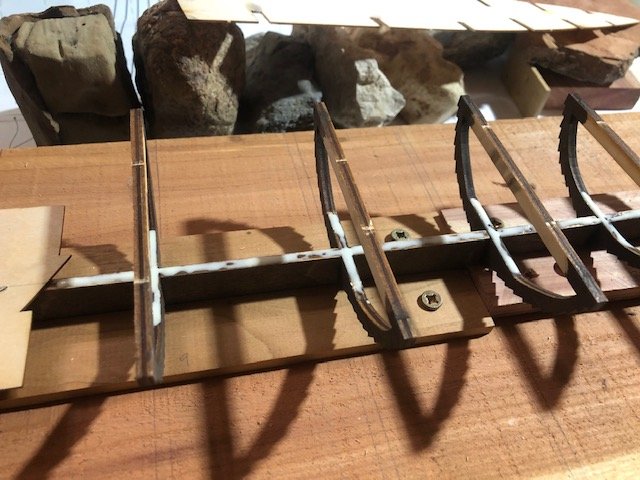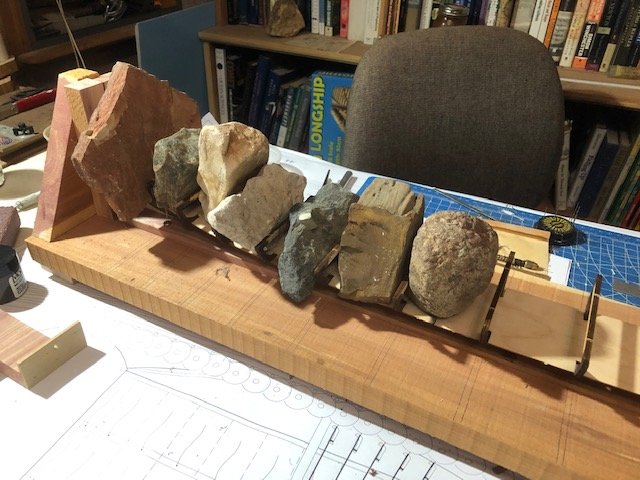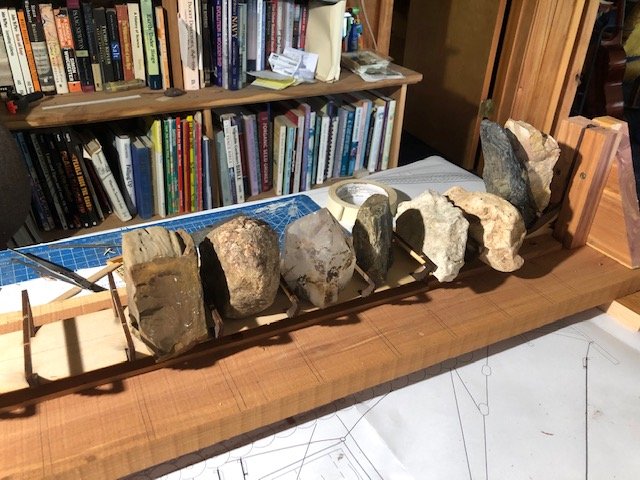-
Posts
3,482 -
Joined
-
Last visited
Content Type
Profiles
Forums
Gallery
Events
Everything posted by Cathead
-
Binho, thanks for that. I have been poking around on the Skuldelev 2 part of that site, but hadn't stumbled on the reconstruction gallery yet, which has lots of good images. The strakes should clearly be composed of many shorter planks rather than a few long ones. I don't fault the kit for this, it makes sense to have it designed as it is for ease of construction. If someone wants to up the realism ante and go for shorter strakes, good for them. The kit's problem is solely in the instructions' total lack of clarity on how you are expected to build the model as scarphed butt joints are impossible under the kit's design. Anyway, last night I worked out how I wanted to approach this and put the first strake on. I wanted to simulate more shorter planks and initially just decided that I would cut the pre-spiled planks into shorter lengths and deal with the butt-joining as best I could. So I marked some locations and tried to use my chopper tool to ensure a clean and square cut: However, the planks are actually quite tough across the grain and the tool only scored the surface. This gave me a rather good idea, in which I realized that a scored joint would look about as good as a full joint without actually compromising the plank. So I did the same all the way along and used a narrow file to widen the "joint" scar slightly since I assumed that subsquent painting/staining would swell the fibres and close it up again. After all, I just want a hint of this pattern as the real joint would naturally be pretty tight. I then did some serious sanding to put the proper angle into the edge of this garboard plank (so it would sit properly against the keel). This angle got broader and broader as the strake curved toward the stem, until by the end I was mostly sanding the plank flat so it would sit flush against the keel rather than on-end to it. Here's a view partway through that sanding. The stain is actually really helpful for judging exactly how far the sanding has progressed. Having done that to my satisfaction for both halves of this strake, I installed one at a time using wood glue and a lot of clamps" It's hard to tell in that evening light but it came out nicely. Will try to take better photos later. I'm going to lay the same strake on both sides of the hull before moving up (rather than planking one whole side first) to help ensure (a) that the hull stays straight and (b) that the strakes line up at stem and stern across the keel as they'll be REALLY visible if they're offset. To handle this first butt joint, I used a scrap piece as a clamp glued behind the two planks. After this, further strakes may not need this given the support of the clinkered plank below; we'll see. Thanks to everyone for helping me talk through this and figure it out. I probably complained more than I should have but it was frustrating there for a bit and I'm kind of on edge overall. I appreciate the patience and the support. This ought to get more fun and interesting as the planking develops.
-
Richard, thanks for that. The documents listed there also clarifies that various scarph joints were used, which makes perfect sense. It's clear that the original didn't space the butts over ribs because these ships were built as open shells and there weren't ribs at that stage of construction, especially in the upper hull. What I'm referring to is model design, because the thin scale planks can't easily be scarphed and it would seem to make life a lot easier for the model building if the joints were designed to fit over the frames during construction. At the very least the instructions could explain what the designer intends the builder to do here. Also forgot to thank Binho for chipping in those insights from the original wreck!
-
Louie, thanks, I know about staggering plank ends and scarphing from previous models. The kit is already designed to alternate plank lengths so that you get a two-strake shift and that can't really be changed given where the planks are already cut. My goal was to at least shorten the planks so there was more than one joint per strake, distributing the look more evenly. However, this is getting even wierder than I thought. I found even more frustration last night when messing with the planking. My initial assumption was wrong: the planks can't be butted over a frame the way they're designed. I rechecked the plans and tested setting two lines of strakes; there is no way to butt the two halves of a given strake over a frame that also makes the plank ends line up properly with the stem and stern curves. Here is what the correct alignment at stem and stern looks like for the first two strakes: You can see how the both planks follow the curve of the keel properly and how the inner one will curve nicely into the outer one. This has to be right; you can't shift these more than a few mm in either direction or the whole assembly is thrown off. However, here's where this places the two butt joints: Why??? Why not design this so these joints fall over the frames? They're not that far away! But there's no allowance for how you're supposed to join these ends. Scarph joints won't work because these are pre-spiled to a pretty tight tolerance. The instructions say absolutely nothing about this. This also screws up my plans to cut these into shorter planks and do a more staggered butt pattern, because I'd really want that centered over frames. For the first strake this will be manageable because I can just glue a wood-scrap clamp behind the joint, as long as it's buried beneath the deck. But I have no idea how this is supposed to work once you get above the deck. And I want to define my butt-joint pattern now rather than altering it partway along. This is the downside of pre-spiled planks. They make life easy when they're done right, but also allow for very little adaptation. WIth a bunch of strip wood, I could design my own pattern and cut them where I please, but I have to work with these or cut all my own planks from new stock, which I'd really rather not do as (a) I don't have it (b) I don't want to and (c) this was meant to be a relaxing model, not another scratchbuild. A final point: All the frames above the deck are just for construction, as this vessel didn't have frames extending up that far. What you're supposed to do is plank the whole hull, then cut out the frames above the deck, leaving a hollow planked shell (this is also not obvious from the instructions and I had to confirm it through PMing with Binho; I was going to mention this when I got there as anothe flaw in the directinos). Which means that all the butt joints above the deck won't be supported by anything. So how does the kit expect those joints to be made in a way that stays strong enough? Is the assumption that the clinker overlap will hold them in place? Maybe that is the answer, the more I think about it. Still seems odd, and it should certainly be explained in the instructions as it's not typical for modellers used to carvel planking. Just going to keep mulling this over and see if something brilliant occurs to me. As no one has recorded a log for this model before, I don't have a direct reference. Binho built the 1:72 version, but that one was small enough it looks like all the strakes came in one piece, so this wasn't an issue. I reviewed a few logs for the Dusek 1:35 Gokstad ship just in case the design had a similar flaw, but they didn't mention this problem and just show a nicely planked hull with joints that seem to be over the frames.
-
All the planks in this kit are pre-spiled, so I pre-stained them within the laser-cut sheet so that the framing around them would minimize unwanted warping: The thin sheets these are cut from have a pretty strong swirling wood grain that creates some strange patterns on the planks (not at all realistic for scale wood grain). My goal is to repaint/stain the hull, especially the outside, once it's assembled to minimize this effect. For now, I just want the planks to have a base color that stays relatively dark if/when I have to do minor sanding or shaping. The instructions, once again, leave much to be desired when trying to explain how to actually do the planking. Each strake is made up of two pieces (labelled a and b by strake number, as in 17a and 17b), but nowhere do the instructions specifically tell you in which direction these are meant to go on the hull. Each planking sheet has an arrow referred to as "planking direction", and one could assume the arrow points toward the bow, but it never actually says this. They also never explain how to handle the butt joint between the two strakes. It would make sense to me that these are meant to go over one of the frames for maximum strength, but one of the 3D drawings in the instructions clearly shows butt joints shifted away from the frames, which makes no sense to me as you'd have to use some kind of parallel reinforcement and that would ruin the look of the planking in an open boat. I think that drawing is just sloppy, but it's concerning as there's no clear answer. The plans have a full-scale side view but don't show butt joints (each strake is shown as a single piece). There's also no guide for how and where the tips of the planks are supposed to run up the curved stem and stern; you're just supposed to guess? I think I have to proceed on the assumption that planks are butted over frames. A test fit of the first garboard plank (below) implies that placing its end over a frame puts the tip in about the right place on the stem. This would mean that, in theory the location at stem and stern would take care of themselves as the precut plank lengths will determine where the tips go. Still makes me nervous to have so little guidance. So far, the kit itself seems to be reasonably well thought-out but the instructions leave out a LOT of critical information regarding how you're actually supposed to proceed. There will be more examples of this soon, but I'll cover them when I get there. For now, I'm waiting for the stained planks to dry and probably won't get back to this until sometime Sunday as I'm spending the rest of today helping my in-laws and have to work part of Sunday to make up for work time lost during the week to other issues. Thanks for reading, let me know if any of this doesn't make sense or if you have other ideas. As always, talking about builds like this is so much better than just going it alone. EDIT: I meant to ask another question. The fact that each strake is made up of only two pieces makes for unnaturally long planks and only two butt joints in the whole hull. I'm thinking about cutting these down to make shorter sets of planks that are still butted over frames but far more often, as I think this would look good and more realistic. GIven the pre-spiling, I don't think this would hurt anything? Thoughts? How long would a typical plank in this era be? I know 20-30' is a good guess for the later Age of Sail, but have no idea for this era.
-
And here I thought all these dudes needed tattoos to keep things straight. NO, Thermocles, your OTHER starboard! Nice revision on the arm method.
-
Agreed, hard to say what it's "supposed" to look like but it creates a really nice weathering effect. One thing I learned long ago from model railroading was that models often look best when they "feel" right rather than when they "are" right. Sometimes that means actually making them less than perfect in order to hit the eye the right way.
-
Right now I feel like they're pretty firm and don't need a temporary gunwale, but it's a good suggestion and I appreciate it.
-
Here's the upside-down stand I cobbled together from the existing one, basically by turning the vessel upside down and adding some vertical supports using scrap wood and hardware from my workshop. This won't allow me to plank all the way, but will let me get a series of strakes on that will help stabilize the hull. Once I get that far I'll decide how to modify things to proceed further. Hopefully I get to work on this over the weekend, life continues to be a real bear lately.
-
Seems reasonable? One of those things you may notice but no one else will, and that will vanish into the overall coolness of the finished model. Would it work to sand down the outer edge a bit to minimize the thicker shadow, or would that mess up the staining?
-
I can't quite tell how that blends into the rest of the run of planking, but of course you have a better in-person view of how it all fits together.
-
Welcome from central Missouri! I've built a BlueJacket lobster boat and had a great time with it. Here's a review I wrote that might be of interest to help you avoid a few quirks.
-
When you start typing a reply, look at the toolbar immediately above the text box, which has all sorts of text formatting tools. Hovering your mouse cursor over each one will tell you what it does. About halfway along is one that looks like a chain that lets you link text. So just select and copy the URL for a given log, then select whatever text you want to represent the link, then click the link tool and paste it in. So, for example, the URL for my build log is https://modelshipworld.com/topic/24932-viking-longship-by-cathead-dusek-135/ If I want to link it in the text "the link to my build log", I copy the URL above, select "the link to my build log", click the link tool, copy the URL into the URL box in that tool, and the result is: "the link to my build log" If you want to link to a specific post within a log, look for the number in the upper right corner of the post (i.e. #20). Right click that and select "copy link location". Now that you have the link to that specific post, use it with the above instructions. Is that clear enough? It's always hard to write these things out.
-
On the brickwork, I think I used printed brick paper (from model railroading) on the Bertrand and made my own wooden bricks for Arabia. I don't think the former would hold up at your scale. There are a lot of model railroad molds out there intended for casting various building parts in plaster, I wonder if a brick pattern mold could be found that would look right? That would give you a nice 3D effect without having to cut out and shape lots of bricks.
-

Exploring the maritime history and geography of Chile
Cathead replied to Cathead's topic in Nautical/Naval History
German, thanks for reading! Really cool to hear your perspective on being directly involved in so many of the vessels we saw. Can you give me any insights into the basic fishing craft? -
Next step is to add bracing to the top of the frames to hold the whole assembly stiff while planking. This is another example of the instructions being really vague; they refer to using a numbered part for this, but there's nothing in the laser-cut sheets or plans with that number. The kit comes with various strip wood, but there's no parts list to tell you what's what or what it's intended for, and all of it seems to be nicer wood than I'd use for throwaway temporary bracing. So I just used stuff from my scrap bin instead. I did the bow and stern first, using shorter pieces so they'd stay near the outer edge of the frames: Then filled in long straight strips in the middle: Next step is to remove the hull from the building frame and start planking. I'm trying to decide if I want to build/adapt a new building frame to hold it firmly upside down, or just work on it freehand.
-
¡Bienvenido a Model Ship World, German! Me interesa que usted es de Chile. En el año 2018 mi esposa y yo viajamos en su pais para un mes, y pasamos mucho tiempo largo de la costa. Yo escribí sobre esto viaje a Chile en MSW, ¿quizas le interesta leerlo? Planeamos volver, pero ahora no podemos por el virus. Es muy desfortunado, por que durante nuestro viaje nos conocimos a mucho gente y creemos que los Chilenos son muy simpaticos y interesantes. Mi español es limitado, pero he trabajado duro antes del viaje y después, por que los dos queremos volver a su país. Espero que puede me entender. ¡De nuevo, bienvenido!
-
Hah, good point. It would be cool to simulate some of the stone ballast, maybe I need to leave some of the deck planking off. Someone's log also has a super-cool real-stone anchor that I want to copy.
-

Chaperon by joep4567 - 1:48 - Sternwheeler
Cathead replied to joep4567's topic in - Build logs for subjects built 1801 - 1850
Everything looks real nice. -
Time to add the false decks. It took quite a while to carve the frame slots out enough for these to fit properly, but I got there eventually. Part of the slowness was the need to keep sliding the decks back inside the frames to check the fit, which is a delicate process. Once I felt they'd fit, I worked out how to hold them in place while the glue dried. Several people have used various combinations of rubber bands and clamps, but I drew on some resources from my geology background. First, I spread a thick layer of glue on all the keel/frame surfaces, as the fit isn't perfect in a few places, not worrying about spillover since none of this will be visible from any angle: I then used rock samples between each frame, which seemed to work nicely with a minimum of fuss. I did one half of the frame first, then the other. So far so good.
-
Nice start to an interesting build. I'll look forward to following your progress. If it's of interest, feel free to check out my series of photos from a full-scale Beagle replica in southern Chile, which might be helpful or at least inspirational.
About us
Modelshipworld - Advancing Ship Modeling through Research
SSL Secured
Your security is important for us so this Website is SSL-Secured
NRG Mailing Address
Nautical Research Guild
237 South Lincoln Street
Westmont IL, 60559-1917
Model Ship World ® and the MSW logo are Registered Trademarks, and belong to the Nautical Research Guild (United States Patent and Trademark Office: No. 6,929,264 & No. 6,929,274, registered Dec. 20, 2022)
Helpful Links
About the NRG
If you enjoy building ship models that are historically accurate as well as beautiful, then The Nautical Research Guild (NRG) is just right for you.
The Guild is a non-profit educational organization whose mission is to “Advance Ship Modeling Through Research”. We provide support to our members in their efforts to raise the quality of their model ships.
The Nautical Research Guild has published our world-renowned quarterly magazine, The Nautical Research Journal, since 1955. The pages of the Journal are full of articles by accomplished ship modelers who show you how they create those exquisite details on their models, and by maritime historians who show you the correct details to build. The Journal is available in both print and digital editions. Go to the NRG web site (www.thenrg.org) to download a complimentary digital copy of the Journal. The NRG also publishes plan sets, books and compilations of back issues of the Journal and the former Ships in Scale and Model Ship Builder magazines.



